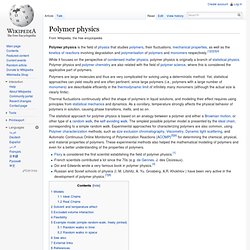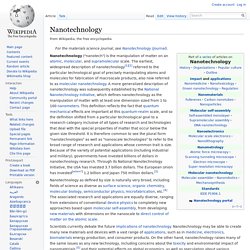

Polymer physics. Polymer physics is the field of physics that studies polymers, their fluctuations, mechanical properties, as well as the kinetics of reactions involving degradation and polymerisation of polymers and monomers respectively.[1][2][3][4] While it focuses on the perspective of condensed matter physics, polymer physics is originally a branch of statistical physics.

Polymer physics and polymer chemistry are also related with the field of polymer science, where this is considered the applicative part of polymers. Polymers are large molecules and thus are very complicated for solving using a deterministic method. Yet, statistical approaches can yield results and are often pertinent, since large polymers (i.e., polymers with a large number of monomers) are describable efficiently in the thermodynamic limit of infinitely many monomers (although the actual size is clearly finite).
Models[edit] Models of polymer chains are split into two types: "ideal" models, and "real" models. Ideal Chains[edit] . Nanotechnology. Nanotechnology ("nanotech") is the manipulation of matter on an atomic, molecular, and supramolecular scale.

The earliest, widespread description of nanotechnology[1][2] referred to the particular technological goal of precisely manipulating atoms and molecules for fabrication of macroscale products, also now referred to as molecular nanotechnology. A more generalized description of nanotechnology was subsequently established by the National Nanotechnology Initiative, which defines nanotechnology as the manipulation of matter with at least one dimension sized from 1 to 100 nanometers. This definition reflects the fact that quantum mechanical effects are important at this quantum-realm scale, and so the definition shifted from a particular technological goal to a research category inclusive of all types of research and technologies that deal with the special properties of matter that occur below the given size threshold. Origins[edit] Cryogenics. Liquid nitrogen In physics, cryogenics is the study of the production and behaviour of materials at very low temperatures (below −150 °C, −238 °F or 123 K).

A person who studies elements that have been subjected to extremely cold temperatures is called a cryogenicist. Rather than the relative temperature scales of Celsius and Fahrenheit, cryogenicists use the absolute temperature scales. These are Kelvin (SI units) or Rankine scale (Imperial and US units). The term cryogenics is often mistakenly used in fiction and popular culture to refer to the very different cryonics. Definitions and distinctions[edit] Cryogenics. High pressure. Percy Williams Bridgman received a Nobel prize for advancing this area of physics by several magnitudes of pressure (400 MPa to 40,000 MPa).

The list of founding fathers of this field includes also the names of Harry George Drickamer, Tracey Hall, F.P. Bundy, L.F. Vereschagin, Sergey M. Stishov. It was by applying high pressure as well as high temperature to carbon that man-made diamonds were first produced as well as many other interesting discoveries. Chemical bonding is likely to change under high pressure, when the P*V term in the free energy becomes comparable to the energies of typical chemical bonds - i.e. at around 100 GPa. High pressure experimentation has led to the discovery of the types of minerals which are believed to exist in the deep mantle of the Earth, such as silicate perovskite, which is thought to make up half of the Earth's bulk, and post-perovskite, which occurs at the core-mantle boundary and explains many anomalies inferred for that region.
See also[edit] Solid-state physics. Solid-state physics is the study of rigid matter, or solids, through methods such as quantum mechanics, crystallography, electromagnetism, and metallurgy. It is the largest branch of condensed matter physics. Solid-state physics studies how the large-scale properties of solid materials result from their atomic-scale properties. Thus, solid-state physics forms the theoretical basis of materials science. It also has direct applications, for example in the technology of transistors and semiconductors. Background[edit] The bulk of solid-state physics, as a general theory and not really a proven form of research, is focused on crystals. The forces between the atoms in a crystal can take a variety of forms. Crystal structure and properties[edit] Many properties of materials are affected by their crystal structure. The sizes of the individual crystals in a crystalline solid material vary depending on the material involved and the conditions when it was formed.
The crystal lattice can vibrate.